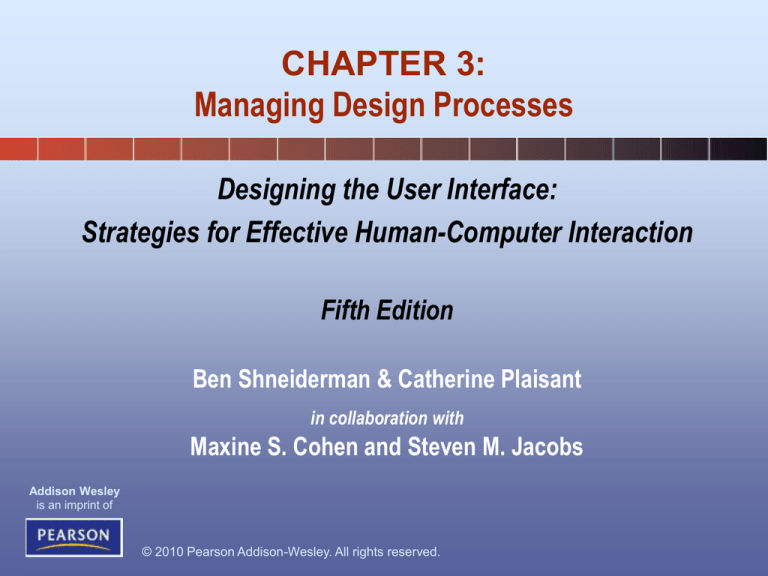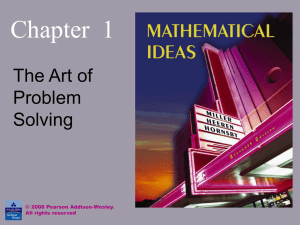
CHAPTER 3:
Managing Design Processes
Designing the User Interface:
Strategies for Effective Human-Computer Interaction
Fifth Edition
Ben Shneiderman & Catherine Plaisant
in collaboration with
Maxine S. Cohen and Steven M. Jacobs
Addison Wesley
is an imprint of
© 2010 Pearson Addison-Wesley. All rights reserved.
Organizational Design and
Support Usability
• Design is inherently creative and unpredictable.
• Interactive system designers blend technical
feasibility with a mystical aesthetic sense of what
attracts users.
• Carroll and Rosson characterize design
–
–
–
–
as a process, not a state
nonhierarchical
radically transformational
intrinsically involves the discovery of new goals
1-2
© 2010 Pearson Addison-Wesley. All rights reserved.
3-2
Organizational Design and
Support Usability
• “Usability engineering” now a recognized discipline with
maturing practices and a growing set of standards
• Usability engineers and user-interface architects are
gaining experience in organizational change
• Numerous papers and reporting address return on
investment (ROI) for usability testing
•
The Usability Professional's Association (UPA) holds
annual meetings called the “World Usability Day”
1-3
© 2010 Pearson Addison-Wesley. All rights reserved.
3-3
The Four Pillars of Design
1-4
© 2010 Pearson Addison-Wesley. All rights reserved.
3-4
The Four Pillars of Design
• User Interface Requirements
– Soliciting and clearly specifying user requirements is a
key to success in any development activity
– Laying out the user-interface requirements is part of
the overall requirements development and
management process
– User interface requirements describe system behavior
• Ethnographic Observation
– Identifying and observing the users in action
– Discussed later
1-5
© 2010 Pearson Addison-Wesley. All rights reserved.
3-5
The Four Pillars of Design
• Guidelines, documents and processes
Each project has different needs, but guidelines should
be considered for:
• Words, icons, and graphics
– Terminology (objects and actions), abbreviations, and
capitalization
– Character set, fonts, font sizes, and styles (bold, italic,
underline)
– Icons, graphics, line thickness, and
– Use of color, backgrounds, highlighting, and blinking
1-6
© 2010 Pearson Addison-Wesley. All rights reserved.
3-6
The Four Pillars of Design
• Screen-layout issues
–
–
–
–
Menu selection, form fill-in, and dialog-box formats
Wording of prompts, feedback, and error messages
Justification, white space, and margins
Data entry and display formats for items and lists
• Input and output devices
– Keyboard, display, cursor control, and pointing
devices
– Audible sounds, voice feedback, touch input, and
other special devices
– Response time for a variety of tasks
1-7
© 2010 Pearson Addison-Wesley. All rights reserved.
3-7
The Four Pillars of Design
• Action sequences
– Direct-manipulation clicking, dragging, dropping, and
gestures
– Command syntax, semantics, and sequences
– Programmed function keys
– Error handling and recovery procedures
• Training
– Online help and tutorials
– Training and reference materials
– Command syntax, semantics, and sequences
© 2010 Pearson Addison-Wesley. All rights reserved.
1-8
3-8
The Four Pillars of Design
Guidelines creation should be a social process within an organization
to help it gain visibility and build support
1-9
© 2010 Pearson Addison-Wesley. All rights reserved.
3-9
Process of Design
• Usability is designed in from the start
– use a developmental methodology that is
user centered
– don’t call in HCI experts at the end
1-10
© 2010 Pearson Addison-Wesley. All rights reserved.
User-interface software tools
• Storyboards
– can use simple drawing tools
• Paint, Word, Powerpoint
– can be animated
• Flash, Ajax
• Limited functionality simulations
– some part of system functionality provided by
designers
– Visual Studio, Java LightWeight UI Toolkit
– Wizard of Oz technique
1-11
© 2010 Pearson Addison-Wesley. All rights reserved.
3-11
1-12
© 2010 Pearson Addison-Wesley. All rights reserved.
3-12
Expert reviews and usability testing
• Rehearsals and previews for critics
important for opening night of a theatrical
production
• UI designers also need reviews, pilot tests
with users and automated testing tools for
their interfaces prior to release
• Chapter 4 covers in more detail
1-13
© 2010 Pearson Addison-Wesley. All rights reserved.
3-13
Ethnographic Observation
• Preparation
–
–
–
–
–
Understand organization policies and work culture.
Familiarize yourself with the system and its history.
Set initial goals and prepare questions.
Gain access and permission to observe/interview.
Research Methods
• Field Study
– Establish rapport with managers and users.
– Observe/interview users in their workplace and collect
subjective/objective quantitative/qualitative data.
– Follow any leads that emerge from the visits.
1-16
© 2010 Pearson Addison-Wesley. All rights reserved.
3-16
Ethnographic Observation
•
Analysis
–
•
–
–
Compile the collected data in numerical, textual, and
multimedia databases.
Quantify data and compile statistics.
Reduce and interpret the data.
–
Refine the goals and the process used.
Reporting
–
–
Consider multiple audiences and goals.
Prepare a report and present the findings.
1-17
© 2010 Pearson Addison-Wesley. All rights reserved.
3-17
Participatory Design
1-18
© 2010 Pearson Addison-Wesley. All rights reserved.
3-18
Participatory Design
Controversial
•
One the positive side, more user involvement brings:
– more accurate information about tasks
– more opportunity for users to influence design
decisions
– potential for increased user acceptance of final
system
1-19
© 2010 Pearson Addison-Wesley. All rights reserved.
3-19
Participatory Design
•
On the negative side, extensive user involvement may:
– be more co$tly
– l e n g t h e n the implementation period
– build antagonism with people not involved or whose
suggestions rejected
– force designers to compromise their design to satisfy
incompetent participants
– show that organizational politics and preferences of
certain individuals are more important than technical
issues
1-20
© 2010 Pearson Addison-Wesley. All rights reserved.
3-20
Participatory Design
The two blue levels represent stages of participatory design.
1-21
© 2010 Pearson Addison-Wesley. All rights reserved.
3-21
Scenario Development
Day-in-the-life scenarios:
•
•
•
•
characterize what happens when users
perform typical tasks
can be acted out as a form of walkthrough
videotape may be used as basis
useful tools
– table of user communities across top,
tasks listed down the side
– table of task sequences
– flowchart or transition diagram
1-22
© 2010 Pearson Addison-Wesley. All rights reserved.
3-22
Social Impact Statement for
Early Design Review
Describe the new system and its benefits
• Convey the high level goals of the new system.
• Identify the stakeholders.
• Identify specific benefits
1-23
© 2010 Pearson Addison-Wesley. All rights reserved.
3-23
Social Impact Statement for
Early Design Review
Address concerns and potential barriers
•
•
•
•
•
•
•
•
Anticipate changes in job functions and personnel.
Address security and privacy issues.
Discuss accountability for system misuse and failure.
Avoid potential biases.
Weigh individual rights vs. societal benefits.
Preserve democratic principles.
Ensure diverse access.
Promote simplicity and preserve what works.
1-24
© 2010 Pearson Addison-Wesley. All rights reserved.
3-24
Social Impact Statement for Early
Design Review
Outline the development process
•
•
•
•
•
•
Present an estimated project schedule.
Propose process for making decisions.
Discuss expectations of how stakeholders will
be involved.
Recognize needs for more staff, training, and
hardware.
Propose plan for backups of data and
equipment.
Outline plan for migrating to the new system.
1-25
© 2010 Pearson Addison-Wesley. All rights reserved.
3-25
Legal Issues
Potential Controversies
•
•
•
•
What material is eligible for copyright or patents?
What constitutes copyright infringement?
Should user interfaces be copyrighted?
Evolving public policies related to:
–
–
–
Privacy
Liability related to system safety/reliability
Freedom of speech
1-26
© 2010 Pearson Addison-Wesley. All rights reserved.
3-26
Summary
• Usability engineering
– novel ideas standard practices
– important in product planning now
– can use developmental methodologies from
other fields
– ethnographic study provides data to guide
– scenario helps understanding and in
developing usability tests
– need to consider social impacts and legal
issues
1-27
© 2010 Pearson Addison-Wesley. All rights reserved.
3-27







